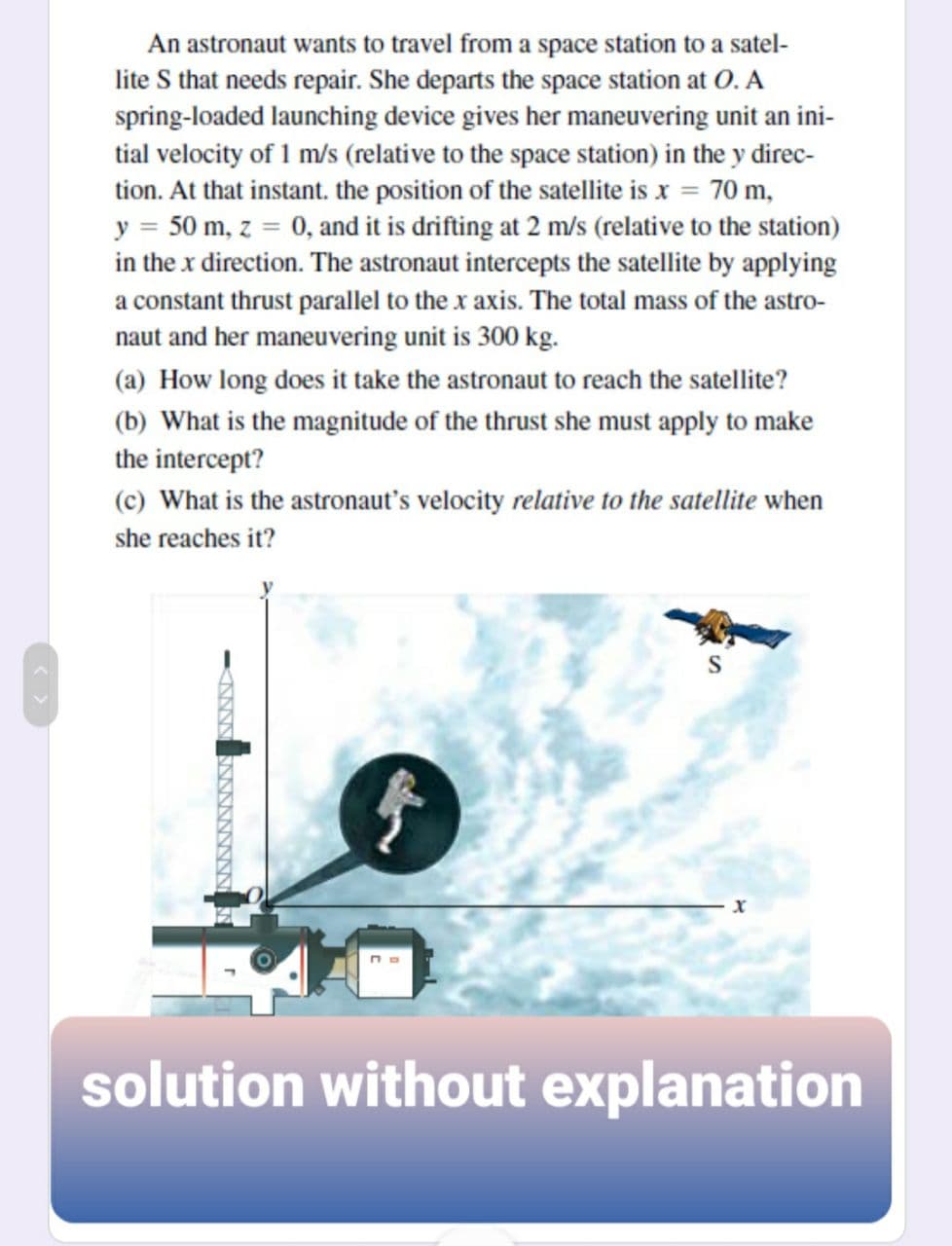(a) How long does it take the astronaut to reach the satellite? (b) What is the magnitude of the thrust she must apply to make the intercept? (c) What is the astronaut's velocity relative to the satellite when she reaches it?
(a) How long does it take the astronaut to reach the satellite? (b) What is the magnitude of the thrust she must apply to make the intercept? (c) What is the astronaut's velocity relative to the satellite when she reaches it?
Elements Of Electromagnetics
7th Edition
ISBN:9780190698614
Author:Sadiku, Matthew N. O.
Publisher:Sadiku, Matthew N. O.
ChapterMA: Math Assessment
Section: Chapter Questions
Problem 1.1MA
Related questions
Question

Transcribed Image Text:An astronaut wants to travel from a space station to a satel-
lite S that needs repair. She departs the space station at O. A
spring-loaded launching device gives her maneuvering unit an ini-
tial velocity of 1 m/s (relative to the space station) in the y direc-
tion. At that instant. the position of the satellite is x = 70 m,
y = 50 m, z = 0, and it is drifting at 2 m/s (relative to the station)
in the x direction. The astronaut intercepts the satellite by applying
a constant thrust parallel to the x axis. The total mass of the astro-
naut and her maneuvering unit is 300 kg.
(a) How long does it take the astronaut to reach the satellite?
(b) What is the magnitude of the thrust she must apply to make
the intercept?
(c) What is the astronaut's velocity relative to the satellite when
she reaches it?
S
solution without explanation
Expert Solution
This question has been solved!
Explore an expertly crafted, step-by-step solution for a thorough understanding of key concepts.
Step by step
Solved in 3 steps

Knowledge Booster
Learn more about
Need a deep-dive on the concept behind this application? Look no further. Learn more about this topic, mechanical-engineering and related others by exploring similar questions and additional content below.Recommended textbooks for you

Elements Of Electromagnetics
Mechanical Engineering
ISBN:
9780190698614
Author:
Sadiku, Matthew N. O.
Publisher:
Oxford University Press

Mechanics of Materials (10th Edition)
Mechanical Engineering
ISBN:
9780134319650
Author:
Russell C. Hibbeler
Publisher:
PEARSON

Thermodynamics: An Engineering Approach
Mechanical Engineering
ISBN:
9781259822674
Author:
Yunus A. Cengel Dr., Michael A. Boles
Publisher:
McGraw-Hill Education

Elements Of Electromagnetics
Mechanical Engineering
ISBN:
9780190698614
Author:
Sadiku, Matthew N. O.
Publisher:
Oxford University Press

Mechanics of Materials (10th Edition)
Mechanical Engineering
ISBN:
9780134319650
Author:
Russell C. Hibbeler
Publisher:
PEARSON

Thermodynamics: An Engineering Approach
Mechanical Engineering
ISBN:
9781259822674
Author:
Yunus A. Cengel Dr., Michael A. Boles
Publisher:
McGraw-Hill Education

Control Systems Engineering
Mechanical Engineering
ISBN:
9781118170519
Author:
Norman S. Nise
Publisher:
WILEY

Mechanics of Materials (MindTap Course List)
Mechanical Engineering
ISBN:
9781337093347
Author:
Barry J. Goodno, James M. Gere
Publisher:
Cengage Learning

Engineering Mechanics: Statics
Mechanical Engineering
ISBN:
9781118807330
Author:
James L. Meriam, L. G. Kraige, J. N. Bolton
Publisher:
WILEY